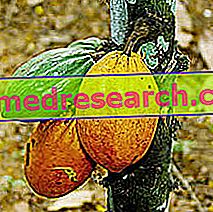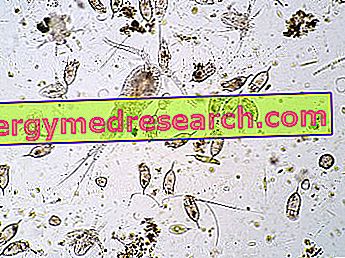
Scientific name
Theobroma cacao L.Family
SterculiaceaeOrigin
Central and South America.Synonyms
"Faba mexicana" and "food of the Gods".
Used Parts
Drug consisting of seeds.Chemical constituents
- Polyphenols;
- Tannins;
- Biogenic amines;
- Lipids;
- Purine alkaloids (caffeine and theobromine);
- Protein;
- carbohydrates;
- Mineral salts;
- Vitamins;
- anandamide;
- Tetraisoisochinoline.
Cocoa in herbal medicine: properties of cocoa
The chocolate produced from the seeds of Theobroma cacao is considered in fact a "functional food", that is a food capable of bringing nutrients to the body and substances capable of producing a positive biological effect on the other. The carbohydrates, the proteins and the lipids contained in it represent a pool with a high nutritional value and are indicated for athletes and asthenic subjects. There is also a small percentage of caffeine in cocoa, about 20% of that contained in coffee seeds, and it is therefore difficult for this food-drug to cause irritability, nervousness or insomnia.
Biological activity
In addition to the known uses in the culinary field, cocoa also has interesting phytotherapeutic properties.
More precisely, the theobromine contained in the plant is ascribed diuretic, vasodilator and bronchodilator activity. Furthermore, all the methylxanthines contained in cocoa (caffeine and theobromine) are also able to exert a stimulating action against the heart muscle.
The polyphenols (catechins and proanthocyanidins) contained within the cocoa beans, on the other hand, have shown to possess marked antioxidant properties, exercised through different mechanisms, including the inhibition of lipid peroxidation; in addition to exerting a protective effect on vascular endothelium through the modulation of nitric oxide production and the inhibition of LDL oxidation.
The properties ascribed to cocoa polyphenols, however, do not end there. In fact, several studies have been conducted on the subject, from which it emerged that - in addition to being significant antioxidant agents - these polyphenols also have an anti-inflammatory activity. This activity is carried out through a mechanism of action that interferes with the production of pro-inflammatory cytokines.
However, despite the results obtained from the various researches carried out so far, the use of cocoa has not obtained official approval for any type of medical application and its therapeutic uses remain limited to traditional medicine.
Cocoa in folk medicine and homeopathy
In folk medicine, cocoa beans are used to treat intestinal infections and diarrhea. Furthermore, the seeds of the plant are also used as a remedy to regulate thyroid function and as a stimulating and secretolytic remedy.
The teguments of cocoa beans, on the other hand, are used by traditional medicine in preparations for the treatment of diabetes and liver and kidney disorders, as well as being used as a tonic remedy and as an astringent in case of diarrhea.
Cocoa is also used in homeopathic medicine, where it can easily be found in the form of granules. In this context, cocoa is used in the case of disorders such as anxiety, stress, mild depression and for the treatment of liver and kidney disorders associated with obesity.
The dose of homeopathic remedy to be taken can be different between one individual and another, also depending on the ailment to be treated and the type of homeopathic dilution to be used.
Side effects
If used correctly, cocoa should not cause any kind of unwanted effects.
However, both cocoa and its derivatives may be responsible for the onset of allergic reactions and / or food intolerances and could cause constipation (due to the content of tannins) and / or favor the appearance of migraine attacks (due to the content of biogenic amines).
Furthermore, excessive consumption of cocoa or its preparations by pediatric children can cause side effects, such as hyperexcitability, increased heart rate and sleep disturbances due to the caffeine content.
Contraindications
The intake of cocoa or its preparations is generally contraindicated in patients suffering from hiatal hernia, because the theobromine contained in them reduces the pressure of the lower esophageal sphincter.
Naturally, the intake of cocoa and its derivatives is contraindicated even in case of known hypersensitivity towards one or more components.
Warnings
Chocolate is contraindicated in patients suffering from hiatal hernia, because theobromine reduces the pressure of the lower esophageal sphincter; furthermore, cocoa and its derivatives can be responsible for allergic reactions, food intolerances and migraines.
Only excessive use can cause side effects from caffeine, similar to those of coffee or guarana.
Pharmacological Interactions
- they are not known at normal consumption rates



